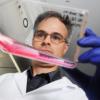Date: 12-12-03
Using green fluroescent protein techniques, researcher have found a way to keep stem cells glowing while their more rapidly dividing progeny become dim thus pointing the way to their hiding place in skin. Very cool.. and I expect very lucrative as well as the stem cells under study can either form new skin OR hair... maybe a cross reference to the Keeping up Appearances thread is coming.. heh..
The system, dubbed "pulse and chase," required development of two different genetically altered mice. In one mouse, a fusion gene (histone H2B-GFP) that can express a green fluorescent protein when cells divide was introduced into a mouse embryo. But in order for the mouse to express this green fusion protein, it needed to be turned on by an "activator" protein. That is where the second mouse came in. The Fuchs lab mated their mouse to one that possessed a second fusion gene (keratin 5-tetracycline-off-activator) that only produces the "activator" protein in the skin epithelial cells. In the final transgenic mice, the glowing histone-H2B-GFP protein was made in all the skin epithelial cells, where it entered the nucleus and bound to DNA. That was the "pulse" part of the formula.
To turn the fluorescent protein off and watch what happened in the "chase," the researchers simply added tetracycline to the mouse food, and no more fluorescent protein was made in the skin. Those cells that rapidly divide soon diluted out their glow and became dim, whereas cells that slowly cycled - the putative stem cells - were the only ones left that glowed brightly. Some cells, the slow-cycling cells, glowed for weeks after others had stopped, says Tumbar.
"After a month the remaining glowing cells, which we predicted to be stem cells, were in the bulge," Tumbar says.
The researchers took those cells out of the bulge, isolated their RNA, and used microarray technology to obtain their "transcriptional profile." (The DNA in genes produces RNA, which codes for protein production). A number of the 150-plus sequences code for proteins that are found on the surface of the slow-cycling stem cells or are secreted by them. Those proteins are new markers that may help find stem cells in human tissue, the researchers say.
The researchers then compared genes found in the skin stem cell niche with those found in blood, neuronal and embryonic stem cells. They found that 40 percent of the genes expressed in slow-cycling skin cells, compared with the genes found in their daughter cells, were also expressed in the other stem cell types. And 80 to 90 percent of the genes expressed in the skin cells were expressed in at least one of the three other stem cell populations.
"This comparison sets the ground for future research regarding similarities between slow-cycling cells and other stem cells," says Tumbar














































